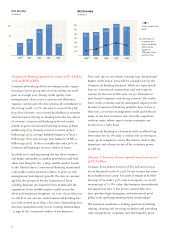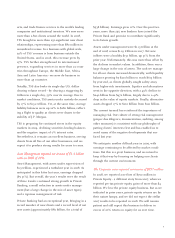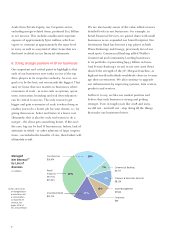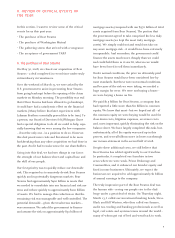JP Morgan Chase 2008 Annual Report Download - page 18
Download and view the complete annual report
Please find page 18 of the 2008 JP Morgan Chase annual report below. You can navigate through the pages in the report by either clicking on the pages listed below, or by using the keyword search tool below to find specific information within the annual report.16
C. The dramatic growth of structural risks and the
unanticipated damage they caused
I believe there are four structural risks or imbalances
that grew and coalesced to cause a “run on the bank.”
But this was not a traditional bank run – it was a run
on our capital markets, the likes of which we had never
experienced. After Lehman’s bankruptcy, many parts
of our capital markets system stopped providing any
capital to the market at all. If the crisis had unfolded
differently, then perhaps the events that followed
would not have occurred. Surely no one deliberately
built a system with these fundamental flaws and imbal-
ances. Clearer heads will understand that much of this
was not malfeasance – our world had changed a lot and
in ways that we didn’t understand the full potential
risk. But when the panic started, it was too much for
the system to bear.
Many structures increasingly allowed short-term
financing to support illiquid assets
In essence, too much longer-term, non-investment
grade product was converted into shorter-term Triple
A-rated product. Some banks, hedge funds, SIVs and
CDOs were using short-term financing to support illiq-
uid, long-term assets. When the markets froze, these
entities were unable to get short-term financing. As a
result, they were forced to sell these illiquid assets.
One of the functions of banking and the capital mar-
kets is to intermediate between the needs of investors
and issuers. This triggers a normal conversion, either
directly or indirectly (through securitizations) of
longer-term, illiquid assets held by the issuers, who
need to finance the business into the shorter-term,
higher-grade product that most investors want. Clearly,
over time, this imbalance had grown too large and
unsupportable.
Money market funds had a small structural risk, which
became a critical point of failure
Money market funds promise to pay back 100% to the
investor on demand. Many money market funds invest-
ed in 30- to-180-day commercial paper or asset-backed
securities that under typical circumstances could be
sold back at par. In normal times, investors demanded
their money in fairly predictable ways, and funds were
able to meet their demands. Over time, money market
funds grew dramatically to exceed $4 trillion. After
Lehman collapsed, one money fund in particular,
which held a lot of Lehman paper, was unable to meet
the withdrawal demands. As word of that situation
spread, investors in many funds responded by demand-
ing their money. In a two-week period, investors pulled
$500 billion from many money funds, which were
forced to sell assets aggressively. To raise liquidity,
these money funds essentially were forced to sell
assets. As investors moved away from credit funds and
into government funds, the banks simply were unable
to make up the difference. This became one more huge
rupture in the dike.
Repo financing terms got too loose, and too many illiquid
assets were repo’ed
Over time, in those markets where financial companies
financed their liquid assets, financial terms had
become too lax. For example, to buy non-agency mort-
gage securities, financial institutions only had to put
up 2%-5% versus a more traditional 15%-25%. The
repo markets also had begun to finance fairly esoteric
securities, and when things got scary, they simply
stopped doing so. In the two weeks after Lehman’s
bankruptcy, more than $200 billion was removed from
this type of financing, by both investors and banks.
Once again, financial institutions had to liquidate
securities to pay back short-term borrowing – thus,
another rupture in the dike.
Investors acted wisely to protect themselves, but the system
couldn’t handle them all doing it at the same time
Individual investors, corporations, pension plans, bond
and loan funds, money market funds and others – all
acted in their own self-interest, and all individually
acted wisely. But collectively, they caused enormous
flows out of the banking and credit system. Regardless
of whether the funds came out of a bank, a money
fund, or a bond or loan fund, the fact remains that the
cumulative result was a severe shortage of necessary
credit that was removed from the system.
























